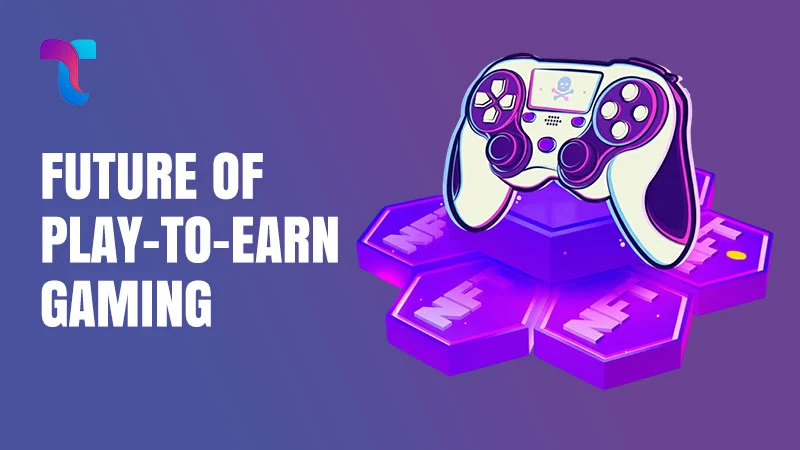What if you were being told that there is a world where gamers don’t just play, they earn? That’s the promise of Play-to-Earn (P2E) gaming!
P2E is a model where players are rewarded with digital assets or cryptocurrencies just for participating in the gameplay.
Unlike traditional gaming, where players invest too much of time and money into a game without owning any part of it, P2E brings a twist to the script. Players can own, trade in-game assets, and earn real income.
Some of the experiments, like CryptoKitties and Axie Infinity, have significantly contributed to the rise of play-to-earn games. Today, play-to-earn has evolved into metaverse games. It has combined virtual worlds, DeFi mechanics, and NFT ownership.
Are you interested in exploring the future of play-to-earn gaming? Here’s a blog for you!
Evolution of the P2E Model
The play-to-earn model has come a long way since its early days. It just started as an experiment with NFTs and tokenized in-game assets and has now become a central part of the blockchain gaming revolution.
It started with blockchain games like CryptoKitties, where players could buy, breed, and trade unique digital cats. These early games introduced the idea of digital ownership through non-fungible tokens (NFTs).
As blockchain technology gained maturity, the concept of GameFi (Gaming + Decentralized Finance) came up. Games like Axie Infinity allowed players to earn tokens with real-world value through regular gameplay. Yield farming, staking, and token-based governance began to integrate into gaming ecosystems, which further created new economic opportunities for players.
Today, the focus is shifting from pure earning to enhanced player experience and true ownership. New models like “Play & Own” emphasize asset utility and long-term value retention, whereas “Play & Create” enable players to contribute to gaming economies. This shows that players are more than just participants; they are co-creators and owners.
Key Trends & Innovations of P2E Powering the Next Era
The future of play-to-earn gaming isn’t just about better graphics or more tokens. It is also about groundbreaking innovations that transform how we play, earn, and interact. Here are the core trends driving the next generation of P2E experiences:
Blockchain Scalability & Layer-2 Solutions
One of the biggest challenges early P2E games faced was slow transactions and high gas fees. The rise of Layer-2 solutions and scalable blockchains has changed that.
Platforms like Polygon, Immutable X, Arbitrum, and Solana now offer fast and low-cost transactions. This enables real-time micro-rewards and seamless gameplay.
These technologies allow developers to design more complex and rewarding in-game economies without sacrificing speed or user experience.
AI Integration in Gaming
Artificial intelligence is unlocking smarter and more personalized gaming experiences. You can expect to see:
- Adaptive storytelling that responds to player choices
- Personalized difficulty levels to keep players engaged
- Dynamic NPCs that evolve and react intelligently
Behind the scenes, AI also plays a key role in monitoring in-game economies, balancing token supply and demand, and detecting fraudulent behavior. This makes P2E ecosystems more stable and secure.
NFTs 2.0 and Dynamic Assets
NFTs 2.0 bring interactivity and evolution to in-game assets. Weapons, characters, and items can now gain experience, level up, or change appearance based on gameplay.
These dynamic assets are powered by advanced smart contracts, which enable features like:
- Royalties for creators on secondary sales
- Interoperability across multiple games or platforms
Mixed Reality (AR/VR) and Metaverse Immersion
As hardware improves, AR and VR are becoming central to immersive gaming. P2E games are now integrating with:
- VR headsets for lifelike gameplay
- Spatial computing for enhanced user interaction
We are also seeing new P2E models like:
- “Move-to-Earn” – where physical activity earns rewards
- “Create-to-Earn” – where users build or design game content for profit
Real-World Examples Leading the Future of Play-to-Earn Gaming
Several of the well-known projects are redefining what’s possible in P2E and blockchain gaming. These are:
Axie Infinity 2.0
Axie Infinity has launched a new version with improved graphics, deeper gameplay mechanics, and a more sustainable token economy. It addresses earlier challenges by focusing on competitive play and long-term player engagement.
Illuvium
Illuvium is an open-world role-playing game (RPG) where players explore, battle, and collect creatures called Illuvials. Built on Ethereum, it combines high-quality visuals with blockchain-based asset ownership and DeFi elements.
Big Time
Big Time is a multiplayer action RPG that rewards players with NFT-based gear and cosmetics. With real-time combat and time-travel-themed gameplay, it offers an accessible entry point to P2E while supporting player-owned economies.
Star Atlas
Built on the Solana blockchain, Star Atlas is a space exploration and strategy game. Players manage fleets, build empires, and trade assets. This makes gameplay decisions financially meaningful and immersive.
Decentraland
Decentraland is a virtual world where users can buy land, create experiences, and monetize their content. It runs on the MANA token and was one of the first platforms to popularize digital real estate and metaverse events.
The Sandbox
The Sandbox empowers users to create, own, and monetize virtual assets and games. With tools for game creation and land NFTs, it enables a “create-to-earn” model that rewards user-generated content and community interaction.
Gala Games
Gala Games is a Web3 gaming platform that supports multiple P2E titles. It offers true ownership of in-game assets and rewards players and node operators with GALA tokens, and supports a decentralized gaming ecosystem.
The Future Landscape of P2E
The play-to-earn model is evolving quickly, and it is only getting started. The global blockchain gaming market is projected to reach $65.7 billion by 2027. This indicates that the next wave of gaming innovation lies in creating ecosystems where ownership, earning, and entertainment
The future promises to be even more transformative!
- The next phase of P2E will all be about sustainable in-game economies, where earning is balanced by real utility and long-term value. Developers will develop P2E games that are fun to play, with economies that reward skill, creativity, and community participation.
- We will also see the rise of cross-platform interoperability, which allows players to use their in-game assets across different games and virtual worlds. It is like owning a sword or NFT skin that works in multiple metaverse games.
- Additionally, AI-driven gameplay and personalized experiences will redefine how players interact with games. It will respond to player behavior and will make P2E worlds more dynamic and engaging.
The End Note
That brings us to the end of this blog!
The play-to-earn games are reshaping how we think about gaming. What started as simple NFT collectibles has grown into engaging ecosystems where players are owners, creators, and earners.
And the future of P2E is about blending fun with real-world value. Also, you will expect more games, better rewards, and more meaningful experiences for players worldwide.
At Technoloader, we are proud to be at the forefront of this transformation. We help bring next-gen gaming projects to life.
So, are you ready to level up your vision? Let’s build it together!
FAQs
What is Play-to-Earn (P2E) gaming?
Play-to-Earn (P2E) gaming is a blockchain-based model where players earn rewards, such as cryptocurrencies or NFTs, for their in-game achievements and participation. Unlike traditional games, players can own, trade, and monetize their in-game assets.
How is P2E different from traditional gaming?
In traditional gaming, players spend time and money without owning in-game assets. P2E changes that by allowing players to own, sell, or trade their digital items.
Are NFTs still relevant in the next era of P2E?
Absolutely! But we are moving beyond static NFTs to NFTs 2.0, which are dynamic and evolve with gameplay. These assets can gain experience, change traits, and be used across different games or metaverse platforms.
What role does AI play in the future of P2E games?
AI enhances gameplay through adaptive storytelling, smart NPCs, and personalized difficulty levels. It also helps manage token economies and detect fraudulent activities, making P2E ecosystems more stable and fair.
Which platforms are leading the P2E space right now?
Some of the top projects include Axie Infinity, Illuvium, Big Time, Star Atlas, Decentraland, The Sandbox, and Gala Games. These offer unique experiences that are all backed by blockchain and Web3 technologies.
How can Technoloader help in developing a P2E game?
Technoloader is a leading play-to-earn game development company that specializes in building custom P2E games. We help turn your gaming vision into reality, so reach out to us now!
 +91 7014607737
+91 7014607737
 info@technoloader.com
info@technoloader.com










